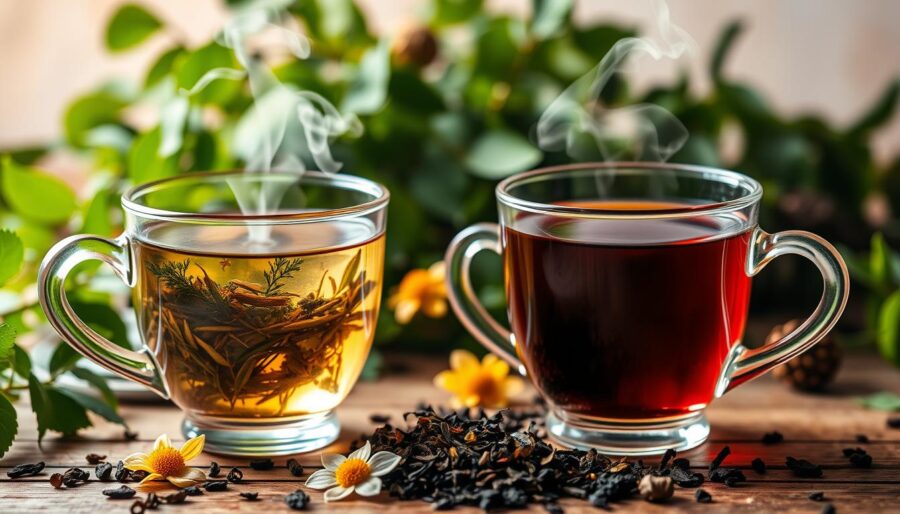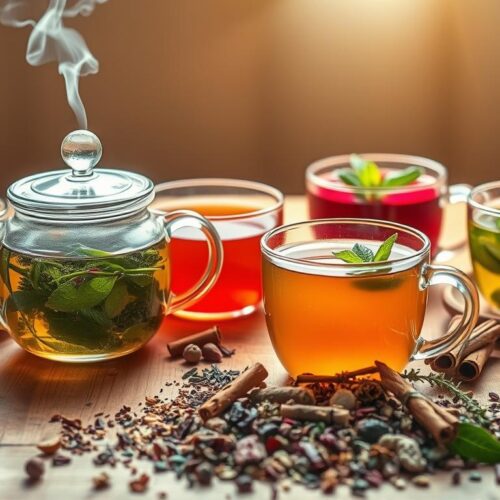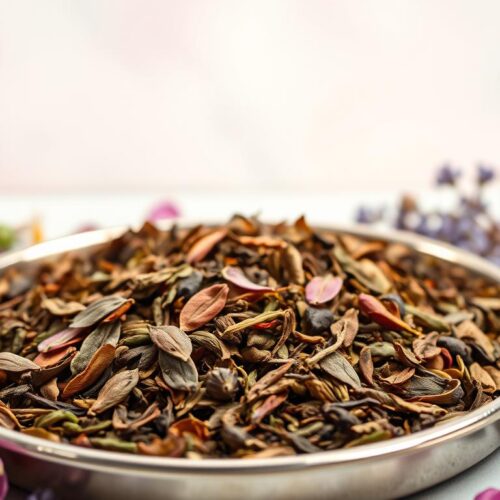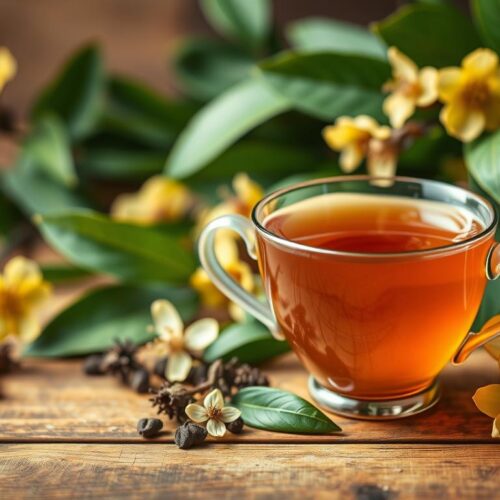People often say “tea” for any hot drink. But there’s a strict definition. True tea comes from Camellia sinensis leaves. Herbal infusions, on the other hand, use herbs, fruits, or spices, not from Camellia sinensis.
The choice affects taste, caffeine content, and cultural practices. True tea comes in varieties like green, black, and oolong, all of which have caffeine. Herbal options usually don’t have caffeine. Some teas, like jasmine or Earl Grey, mix real tea leaves with extra flavors.
Tea has a long history, dating back to ancient China. It has been both medicine and a social drink. Europe got into tea in the 16th century, thanks to Portuguese and Dutch traders. The Boston Tea Party made it iconic in America. Now, the U.S. has matcha bars and sweet tea, showing its diverse tea culture. Yerba mate in the Americas is known for its spiritual significance.
This guide clears up the confusion between herbal and true tea. It outlines the differences in caffeine, flavor, and health benefits. By the end, you’ll know how to choose, make, and savor your cup with confidence.
Understanding True Tea and Herbal Tea
There’s a simple division: true tea comes from the Camellia sinensis shrub, while herbal tea comes from other plants. Brewing Camellia sinensis leaves gives us white, green, yellow, oolong, black, or red tea. Each kind has caffeine and gets its unique taste from oxidation, heat, and time.
Herbal tea, or tisane, is made from different parts of non-Camellia plants. Most are free of caffeine. When we talk, saying herbal tea instead of just tea highlights this difference, though both are commonly called “tea”.
The term “tea” started in Chinese history. It once covered several plants but now strictly refers to Camellia sinensis. Nowadays, we mix true tea with other plants for flavors like jasmine tea, genmaicha, or Earl Grey.
There are thousands of herbal teas, like peppermint and chamomile or rooibos and hibiscus. You have more choices here than with true teas. What you choose depends on your taste, caffeine preference, and whether you like it hot or cold.
| Aspect | True Tea | Herbal Tea | What It Means for You |
|---|---|---|---|
| Botanical Source | Leaves of Camellia sinensis | Non-Camellia plants (flowers, leaves, stems, seeds, bark, roots) | Know the plant origin when comparing herbal tea vs tea |
| Core Categories | White, green, yellow, oolong, black, red | Vast range of single herbs and blends | True tea has set families; herbal tea offers broader variety |
| Caffeine | Naturally caffeinated | Typically caffeine-free | Match your cup to your energy needs |
| Processing Drivers | Oxidation, withering, firing | Drying, cutting, blending | Processing shapes flavor and body |
| Common Blends | Jasmine tea, genmaicha, Earl Grey | Mint mixes, citrus peels, spice blends | Blended cups bridge herbal tea vs tea for nuanced notes |
When looking at labels, check the plant name and style hints. If you see Camellia sinensis, it’s true tea. Names like chamomile or ginger mean it’s an herbal tea. This helps you pick the perfect drink for your mood.
The Types of True Tea
All true tea comes from the Camellia sinensis plant. The differences in each type are due to how they’re treated after being picked. The process of rolling them creates small cracks. This lets enzymes and oxygen mix, which changes their color and flavor.
Black tea undergoes full oxidation. It results in deep brown or red colors and bold flavors. The steps include withering, rolling, oxidizing, and heating to stop the process. Flavors can remind you of dark chocolate, dates, or raisins. Well-known types are Assam, Darjeeling, and Ceylon. Popular blends include English Breakfast and Earl Grey. An 8 oz cup has about 60–90 mg of caffeine.
Oolong tea is a mix of green and black tea characteristics. It’s made by gently tossing the leaves in bamboo baskets. This causes the edges to oxidize but keeps the center greener. Light oolong has floral and smooth tastes. Darker ones offer chocolate and burnt sugar flavors with a deep amber look.
Green tea gets the least processing. It’s quickly heated after a short withering period to stop oxidation. This can be done through pan-firing in China or steaming in Japan. Its flavors range from grassy and vegetal to nutty and roasted. Matcha, where you consume the leaf, has more caffeine.
White tea is the most delicately handled. It’s made from spring buds or young leaves that are lightly dried. Silver Needle, made solely from buds, has a honeysuckle taste. White Peony, a mix of a bud and two leaves, offers a fuller flavor with a pale green to soft yellow color.
Pu-erh tea is another option for enthusiasts. Young raw pu-erh is similar to green tea’s process, but aging it introduces changes. These changes enhance its body and give it an earthy flavor akin to black tea.
- Black tea: fully oxidized; robust color and flavor
- Oolong: partially oxidized; spectrum from floral to toasty
- Green tea: minimally oxidized; grassy to nutty range
- White tea: least processed; delicate and sweet
The Types of Herbal Tea
Herbal tea comes in various forms, using flowers, leaves, roots, bark, fruits, and seeds. They are mostly caffeine-free and are brewed like traditional tea, although they’re not made from the tea plant. Favorites like chamomile, peppermint, and rooibos are seen with blends of spices and fruits.
Flowers such as chamomile and chrysanthemum are common. Mint and lemon balm are among the leafy choices. Roots and bark choices include ginger and cinnamon. Fruits like hibiscus and seeds like anise bring flavor.
Rooibos and honeybush from South Africa have a sweet taste. In the U.S., rooibos is sometimes called red tea for its color and health benefits. It’s often mixed with vanilla or orange for a cozy drink.
Some teas do have caffeine. Yerba mate and guayusa are examples. There are also unique drinks like kava and ayahuasca for specific traditions.
Stores and tea bars have a variety of herbal teas. Ingredients like lemongrass and lavender are popular. Chamomile is for calm, and hibiscus is for a tart taste.
You can make herbal teas at home. Try mixing mint with lemon, or rooibos with ginger. Adding a bit of licorice root can sweeten your blend.
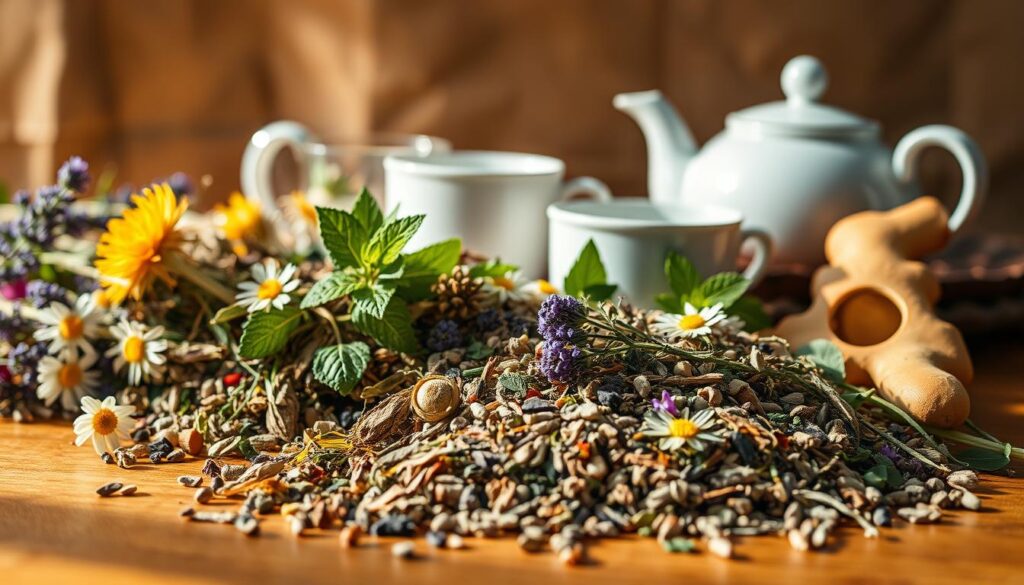
| Category | Common Ingredients | Typical Flavor | Caffeine | Popular Uses |
|---|---|---|---|---|
| Flowers | Chamomile, chrysanthemum, lavender | Soft, floral, honeyed | None (typical) | Evening wind-down, gentle sipping |
| Leaves | Peppermint, spearmint, lemon balm, sage, nettle | Cool, bright, herbaceous | None (typical) | After-meal clarity, daily refreshment |
| Roots & Bark | Ginger, turmeric, licorice, cinnamon | Warm, spicy, soothing | None (typical) | Cozy brews, seasonal blends |
| Fruits | Hibiscus, rose hips, citrus peel, elderberry | Tart, fruity, zesty | None (typical) | Iced blends, bright mixers |
| Seeds & Pods | Anise, caraway, cardamom | Sweet-spice, aromatic | None (typical) | Digestif-style cups, chai-style mixes |
| South African Classics | Rooibos, honeybush | Smooth, nutty, naturally sweet | None | Anytime sipping, dessert pairing |
| Caffeinated Herbals | Yerba mate, guayusa, yaupon, coffee-leaf | Earthy to crisp, brisk finish | Yes | Morning boost, study sessions |
| Cacao-Based | Cacao husk tea | Chocolatey, round | Low (theobromine) | Comfort cups, dessert swaps |
| Complex Blends | Rooibos with spices, fruit, vanilla | Layered, aromatic | None (typical) | Gift sets, menu staples |
Explore different teas and write down your thoughts on their smells, tastes, and how they feel. Compare simple teas to complex blends to find your favorites.
Health Benefits of True Tea
True tea comes in many forms, shaped by post-harvest leaf processing. It has been a part of culture and health since China’s Shang dynasty. From Asian monasteries to ancient Mediterranean texts, tea’s health benefits are widely recognized.
How tea is processed affects what you taste in your cup. Green and white teas are barely oxidized to keep their antioxidants. Black tea goes through full oxidation. This process brings out bold flavors and healthy polyphenols, found in brands like Twinings and Harney & Sons.
Oolong tea finds a balance with partial oxidation. This method gives it a variety of aromas and beneficial compounds. That’s why makers in Taiwan and Fujian focus on getting the roast and fragrance just right. Pu-erh tea offers something unique with its two styles; raw versions are similar to green tea, while aged ones develop complex flavors through fermentation.
Choosing a tea involves considering taste and caffeine content. Black tea provides 60–90 mg of caffeine per 8 oz, more than most teas. Matcha contains even more caffeine since it includes the whole leaf. People often drink green tea in the morning and oolong in the afternoon for a mix of alertness and flavorful aroma.
Tea’s health benefits are part of rituals that bring people together. Brewing tea with attention to water temperature, steeping time, and leaf quality honors a tradition. This tradition focuses on both flavor and well-being.
- Green tea: minimal oxidation, fresh taste, noted for high antioxidant content.
- Black tea: full oxidation, robust body, steady caffeine for focus.
- Oolong: partial oxidation, layered aromas from floral to roasted.
- Pu-erh: raw and aged styles, evolving complexity over time.
When comparing different teas, your choice reflects your daily habits, taste preferences, and the desired feeling after drinking. Making a selection supports a rich tradition while fitting into your lifestyle.
Health Benefits of Herbal Tea
People enjoy herbal tea for its comforting feel, hydration, and rituals. Ayurveda and Traditional Chinese Medicine have used herbal teas to help with digestion, sleep, and mood for centuries. Now, many pick chamomile or rooibos to enjoy a caffeine-free drink that still offers health benefits.
Chamomile can calm you down before bedtime, while rooibos is smooth and full of healthy polyphenols. Mint, lemon balm, ginger, and hibiscus are also popular choices. They help you drink more water and add taste without sugar.
Certain plants have chemicals that can affect you in different ways. Yerba mate, guayusa, and yaupon have caffeine. Cacao gives you theobromine, and kava brings kavalactones. You can find teas that relax you without making you feel drugged. They still offer health benefits that fit your daily life.
It’s important to use herbs safely. Comfrey is not safe to eat, especially when pregnant or taking medicines. Lobelia can be harmful in large amounts. St. John’s wort and grapefruit might change how medicines work in your body. Always choose teas from good sources to avoid pesticides or heavy metals, and protect your teeth from acidic teas like hibiscus.
In the United States, herbal tea is seen as a food product. This means it has to be safe but not necessarily proven to be effective. Always read the labels, notice how the teas make you feel, and talk to a doctor about using them long-term, especially if you’re on medications.
| Herbal Infusion | Primary Traditional Use | Notable Compounds | Potential Tea Health Benefits | Key Precautions |
|---|---|---|---|---|
| Chamomile (Matricaria chamomilla) | Calming and sleep support | Apigenin, bisabolol | Relaxation, gentle digestive ease | Possible ragweed-family allergy |
| Rooibos (Aspalathus linearis) | Daily antioxidant beverage | Aspalathin, quercetin | Smooth flavor, caffeine-free hydration | Monitor if on iron-binding therapies |
| Ginger (Zingiber officinale) | Digestive comfort | Gingerols, shogaols | Settles stomach, warming circulation | May affect anticoagulant response |
| Hibiscus (Hibiscus sabdariffa) | Tart, cooling drink | Anthocyanins, hibiscus acids | Refreshing hydration | Acidic; watch enamel and reflux |
| Mint (Mentha × piperita) | Digestive ease and clarity | Menthol, rosmarinic acid | Cool sensation, post-meal comfort | May aggravate reflux in some people |
Opt for loose leaf or well-sourced tea bags from brands you trust. Use fresh, hot water to make your tea. Always steep it covered to keep the aroma. Notice how chamomile, rooibos, or ginger makes you feel. This way, you’ll enjoy the health benefits of your tea fully.
Caffeine Content Comparison
You might wonder how herbal tea stacks up against regular tea during your day. True teas, from the Camellia sinensis plant, naturally contain caffeine. The caffeine level in your cup can change based on the tea’s grade, the water’s heat, and how long it steeps. So, the strength of your brew plays a big role.
On average, you’ll find about 60–90 mg of caffeine in an 8-ounce cup of black tea. Green, white, and oolong teas usually have less caffeine. But if you steep them longer or use hotter water, they can have more. Matcha often has more caffeine than black tea because you drink the ground-up leaves.
Herbal teas mostly don’t have caffeine. But there are a few exceptions. Yerba mate, guayusa, and yaupon holly naturally have a kick. Cacao husk teas add a bit of caffeine and theobromine, while coffee-leaf or blossom teas have more caffeine.
Tea blends like Earl Grey, jasmine green, or genmaicha do have caffeine because they’re made with a tea base. If you want to avoid caffeine, look for pure herbal blends. Check the labels from brands like Twinings, Harney & Sons, or Traditional Medicinals.
| Beverage | Typical Caffeine Content (per 8 oz) | What Affects Levels | Notes |
|---|---|---|---|
| Black tea | 60–90 mg | Leaf grade, rolling, boiling water, 3–5 min steep | Higher than most true teas; bold flavor supports milk. |
| Green tea | 20–45 mg | Spring harvests, 160–180°F water, 1–3 min steep | Lower than black tea; delicate leaves scorch if overheated. |
| White tea | 15–35 mg | Bud-to-leaf ratio, light oxidation, short steeps | Gentle body; content rises with longer infusions. |
| Oolong | 30–50 mg | Oxidation level, multiple infusions | Moderate caffeine; complex aroma across steeps. |
| Matcha (ceremonial) | 70–140 mg | Serving size (1–2 g), whisking intensity | You ingest the powdered leaf; can exceed black tea. |
| Herbal blend (chamomile, peppermint, rooibos) | 0 mg | Pure non–Camellia ingredients | Default caffeine-free option for evening. |
| Yerba mate | 65–85 mg | Leaf-to-water ratio, gourd refills | Popular in South America; brisk and earthy. |
| Guayusa | 60–90 mg | Steep time, leaf cut | Smooth profile; steady lift without sharp bite. |
| Yaupon holly | 30–60 mg | Roast level, steep length | North American native with mild sweetness. |
| Cacao husk infusion | 0–15 mg | Husk quality, steep time | Rich cocoa aroma; adds theobromine for gentle energy. |
| Blends with tea base (Earl Grey, jasmine, genmaicha) | Matches base tea | Base type and ratio of herbs to tea | Herbs do not cancel caffeine; check blend details. |
Choosing between herbal tea and regular tea depends on what you’re after. For a morning pick-me-up, black tea or matcha are great picks. Oolong or green tea is perfect when you need balance; herbal teas are best for relaxing nights.
Yerba mate is a good choice if you want a consistent energy boost without coffee’s flavor. For zero caffeine, turn to rooibos, chamomile, or peppermint. These help you relax and unwind.
Flavor Profiles: True Tea vs. Herbal Tea
True tea has a unique taste due to oxidation. In black tea, complete oxidation creates a rich color and strong taste. It often has hints of malt, cocoa, dates, or raisins. Oolong tea has a range of flavors, from light and floral to rich notes of toasted sugar and chocolate.
Green tea’s flavor is shaped by its processing. Chinese styles are nutty, toasty, or have a vegetal taste. Japanese steamed versions like sencha are grassy, bring a hint of the ocean, and have a sweet-green tone. White tea is milder, with a touch of honey and gentle floral notes.
Herbal tea offers a wide range of tastes. Hibiscus and rose hip make a tart, bright red drink with brisk acidity and a juicy end. Rooibos is smooth and naturally sweet. Chamomile tastes like apples, ginger is spicy and warm, and mint refreshes with its bright smell.
Citrus peel adds zest and a bit of lift. Lavender and lemongrass bring floral and citrusy notes. Butterfly-pea flower turns blue, and with lime, it changes to violet. Most fruit blends use hibiscus for a thicker feel and color, even if berries are the main flavor.
- Black tea: strong, with malt and cocoa notes; color varies from brown to burnt red.
- Green tea: from grassy to nutty, depending on how it’s made and where it’s from.
- Oolong: turns from floral and creamy to caramel and chocolatey as it oxidizes more.
- White tea: soft, with a hint of honey and a light sweetness.
- Herbal tea favorites: tart hibiscus, creamy rooibos, sweet chamomile, spicy ginger, refreshing mint, zesty citrus, and floral lavender.
When exploring different teas, consider their color, feel in your mouth, and aftertaste. True tea’s flavor comes from how much the leaves oxidize. Herbal tea gets its taste from various plants and how they’re mixed or brewed.
Preparing True Tea
You improve the taste by adjusting water temperature, steeping time, and how much tea you use. Always choose fresh, filtered water. Make sure to warm your teapot or gaiwan first. Generally, use about 2–3 grams of tea for every 8 ounces of water. When making tea, stop as soon as it starts to taste just right—strong but not bitter.
For black tea, you want hotter water because the leaves are fully oxidized. Heat the water until it’s just below boiling, then steep. This way, your tea will be rich but smooth. Stop steeping the moment it begins to taste too strong to avoid bitterness.
Green tea needs cooler water to protect its delicate flavors. Keep the water between 160–175°F, which is especially important for Japanese green teas like sencha. These can taste too grassy if steeped too hot. Chinese green teas, like Longjing, do better with water that’s a bit warmer. This helps bring out their subtle roasted flavors.
Oolong tea, which is partially oxidized, is best enjoyed with short, repetitive steeps. This method, known as gongfu brewing, is popular in China and Taiwan. It allows the tightly rolled leaves to open slowly, releasing a complex aroma. This method highlights the traditional way of processing oolong leaves, where they are rolled in bamboo baskets.
White tea is best with a gentle touch. Use slightly warm water and steep it longer than other teas but lightly. This way, you’ll experience the full floral range of flavors. Silver Needle, for example, will show its sweet honeysuckle taste. White Peony will offer a fuller body. Aim to keep your tea light in color and rich in scent.
Pu-erh tea changes based on its type. Treat fresh raw pu-erh cakes like green tea, using cooler water and short steeping times. Older, post-oxidized cakes can take hotter water and multiple steeps. This process reveals their deeper, earthier flavors and smooth finish over time.
- Water quality: filtered or spring water enhances clarity.
- Leaf-to-water ratio: adjust to taste; more leaf shortens time.
- Time control: taste between seconds to prevent bitterness.
- Decant fully: separate liquor from leaves to avoid over-extraction.
When preparing any true tea—be it black, green, oolong, white, or pu-erh—the right temperature, pure water, and careful timing highlight the tea’s origin and maker’s skill. Always jot down your methods to ensure you can make your best cup every time.
Preparing Herbal Tea
Starting with herbal tea is easy. Just pour hot or boiling water over clean plant bits. Then, let them sit. For flowers and leaves, like chamomile and lavender, use water at 190–205°F for 4–7 minutes. But roots, like ginger, need 10–20 minutes or a low boil for deeper flavors.
Teas can mix leaves, fruits, and spices for cozy drinks. Like rooibos with ginger and cinnamon, or tangy hibiscus. To make it smooth, try soaking it in the fridge overnight, strain and enjoy cold.
Unique tools can enhance the experience. Use a gourd for yerba mate and sip through a bombilla straw. Sweeten with honey, or add lemon for flavor. Milk softens rooibos, while cinnamon is great with chamomile. Lemon juice changes the color of some teas to violet.
When making herbal tea, picking safe and high-quality ingredients is key. Only use plants safe for eating, avoiding harmful ones like comfrey. Pick brands that check for chemicals, and store herbs properly. Remember, they’re best used within six to twelve months.
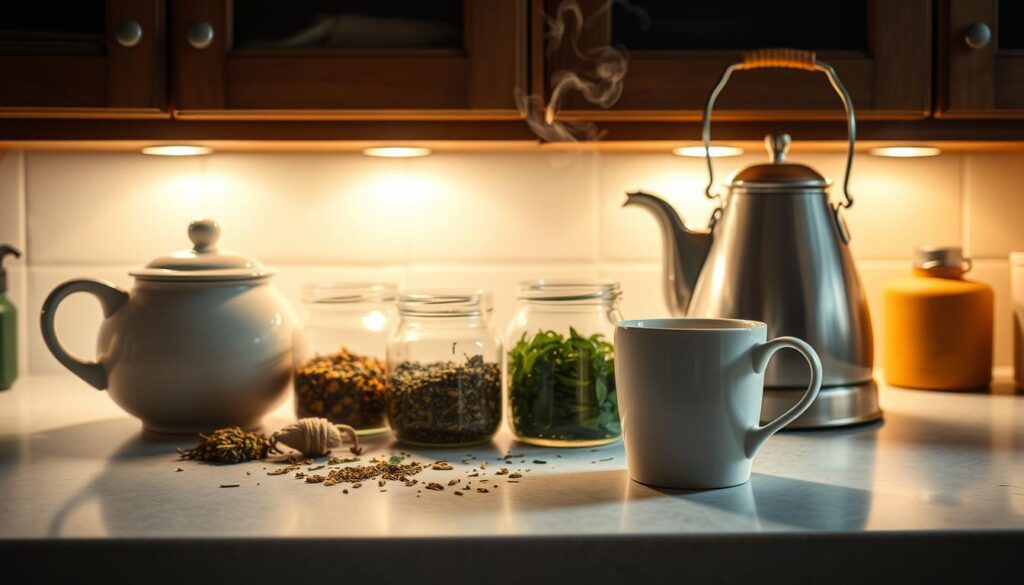
- Quick infusers: chamomile, mint, lemon balm, lavender
- Long steep or decoction: ginger, licorice, cinnamon chips
- Blend ideas: rooibos with coconut and cardamom; hibiscus with orange peel
- Cold infusions: 6–12 hours in the fridge, then strain
- Add-ins: honey, lemon, milk, spices; adjust to taste and color
Cultural Significance of Tea
When a kettle sings, you’re entering the world of tea culture. In China, the journey of tea began as a medicinal herb during the Shang dynasty. It became part of everyday life in the Tang era. Portuguese priests introduced tea to Europe in the 15th century. By the 17th century, tea had become a staple in Britain, tied to the East India Company and events like the Boston Tea Party.
In places like Argentina, Paraguay, and Uruguay, sharing a yerba mate gourd and bombilla means trust among friends. This brew is called “the drink of the gods”. The experience deepens as people slow down to reflect and talk.
Rituals around tea vary by location and purpose. Japan’s chanoyu ceremony values grace and careful attention. In Morocco, mint and green tea welcome guests. India’s roadside chai stands offer news, spice, and warmth. Each tradition influences how we meet, greet, and engage with each other.
Tea also influences economies. As of 2016, China and India produced over half of the world’s tea. Kenya’s economy benefits from tea exports, which help its farms and towns. The art of tea preparation is highlighted by special cups, kettles, and clay pots. These rituals signal moments of pause, peace, and care.
In the United States, tea culture mixes tradition with new trends. Matcha is now popular at Starbucks, and places like Ten Ren Tea sell gongfu sets. At Samovar Tea Lounge, you can find boutique tea flights. Specialty shops offer tastings that blend deep tea knowledge with local stories and designs.
| Region/Tradition | Signature Practice | Beverage Focus | Social Meaning | Notable Brands/Spots |
|---|---|---|---|---|
| China | Gongfu brewing with small pots | true tea (oolong, pu-erh, green) | Scholarship, hospitality, memory | Ten Ren Tea, Zhejiang Longjing markets |
| Japan | Chanoyu ceremony with matcha | true tea (matcha, sencha) | Harmony, respect, mindfulness | Ippodo Tea, Uji tea houses |
| Britain | Afternoon tea with scones | true tea (black blends) | Ritual, comfort, daily pause | Twinings, Fortnum & Mason |
| Southern Cone | Shared gourd and thermos | yerba mate | Community, conversation, belonging | Taragüi, Amanda |
| Morocco | High-pour mint service | true tea (green with mint) | Welcome, generosity, craft | Medina tea salons |
| United States | Specialty cafés and tastings | true tea and herbal infusions | Discovery, wellness, design | Harney & Sons, Samovar Tea Lounge |
Choosing the Right Tea for You
Begin by thinking about what you want from your tea. If it’s caffeine and a traditional taste you’re after, choose true teas. Black tea offers a strong flavor and the most caffeine, with about 60–90 mg per cup. Green tea has a fresh taste, ranging from grassy to slightly roasted flavors. Oolong can taste like flowers or caramel, and white tea is delicate and sweet.
If you don’t want caffeine, go for herbal teas. Rooibos is smooth, has few tannins, and a sweet, honey-like finish. Chamomile is soft, with a hint of apples, perfect for relaxing. Mint is refreshing and cleanses your mouth. Hibiscus is tart and makes a bright red drink. Choose honeybush, lemon balm, or ginger for benefits without caffeine. Yerba mate, guayusa, or yaupon offer a natural boost without the usual tea plant.
Think about what you’re in the mood for. Want something visually stunning? Try butterfly-pea tea, it changes from blue to purple with citrus added. Be mindful of acids in teas like hibiscus to care for your teeth. Check how teas might affect any medications you’re taking, like St. John’s wort or grapefruit. Always buy tea from trusted sellers to avoid contaminants.
Discover teas that mix tastes and smells for something special. Jasmine adds a floral touch to green tea. Genmaicha combines roasted rice with green tea for a rich flavor. Earl Grey blends black tea with zesty bergamot. When deciding between herbal and true tea, think about your goal: whether it’s focus, clarity, or relaxation you’re seeking.

